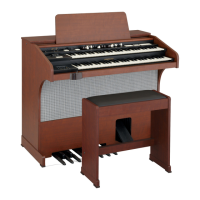*#1 #52
Owner’s Manual
34
5
1
/3'
16' 8' 4'
2
2
/3'
2'
1
3
/5'1
1
/3'
1'
Middle “C”
e 9 Drawbars for each keyboard (plus 2 for the Pedal) of the A-405SP organ are
used to make the basic sounds. Each Drawbar is marked with the numbers 1 - 8. If
you push back the Drawbar until you can not see any number at all, the sound of
the Drawbar is not heard. If you pull it out to the fullest position the sound level is
maximum.
Except when the Preset button is [CANCEL], the actual Drawbar Registration is
the value displayed in the (display-)window. e “Drawbar Registration” shows the
length of the pulled-out Drawbar(s). e display shows only the Drawbar(s) you
operate.
e pitch of each Drawbar is as shown above, when the middle C is depressed. e
footage marked (´) on each Drawbar is originated from the length of the pipes of a
pipe organ.
e numbers 1 - 8 on each Drawbar indicate the volume of the sound to be produced
as well as the guide to set the Drawbar.
For example, when you play a clarinet, the internal air vibrates, and the fundamental
(8´) and the third harmonic (2⅔ ´) plus the fi fth harmonic (1⁄´) are the basic compo-
nents of the tone. On the A-405SP (or any Hammond Organ), if you pull out these
3 Drawbars, you can get a clarinet-like sound. If you pull out the 1⁄´ Drawbar and
push in the 8´ Drawbar a little shorter, the element of the high pitch increases and a
“hard” sound results. Conversely, if you pull out the 8´ one a little longer, the sound
gets mellower.
e millions of combinations possible allow you to make delicate changes to the
sound, depending on the fl ow of the tune or your choice, by fully utilizing the Draw-
bars.
NOTE: You can change the characters of the Drawbars. (P. 58)
HARMONIC DRAWBARS™

